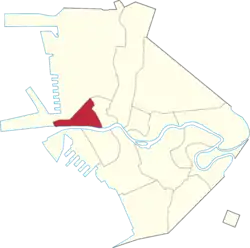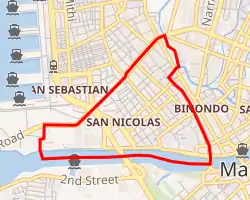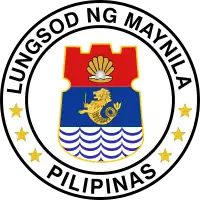San Nicolas, Manila
San Nicolas is one of the sixteen districts in the city of Manila in the Philippines. It is located at the west central part of the city, on the northern bank of Pasig River[2] bounded by the districts of Binondo to the east by Estero de Binondo, and Tondo to the north and west by Circumferential Road 1, and by the Pasig River to the south. Considered as a heritage district of Manila,[3] this community has kept its 19th-century ancestral houses, which symbolizes the wealthy lives of the people who used to live there, similar to the ancestral houses of Silay and Vigan.
San Nicolas | |
|---|---|
District of Manila | |
 The intersection of Madrid and San Fernando Streets, in front of the San Nicolas Fire Station | |
 | |
 | |
| Country | Philippines |
| Region | National Capital Region |
| City | Manila |
| Congressional district | Part of the 3rd district of Manila |
| Barangays | 15 |
| Population (2020) | |
| • Total | 42,957[1] |
| Zip codes | 1010 |
| Area codes | 2 |
As of the May 1, 2020 national census, the population of San Nicolas, which is composed of 15 barangays named as numbers from 268 to 276 and from 281 to 286, is 42,957. This is slightly lower than the 2010 census that counted San Nicolas residents at 44,241.[1]
History
San Nicolas was originally a fishing town named Baybay, which is also a Tagalog word for shore.[4] Regalado Trota Jose, a historian, mentions San Nicolas in his book about bells as the formerly Baybay town during the late 16th century.[3] San Nicolas is the western part of the first Chinatown in the Philippines, and perhaps the world.[5] The eastern part of the Chinatown is Binondo, which was founded in 1594 by Governor-General Luis Perez Dasmariñas.[5] The Dominican order came to western part of Chinatown in 1596[5] and then founded San Nicolas in 1598.[3] This was the first mission by the Dominicans outside Intramuros.[3]
In 1901, during the American colonization of the Philippines, Daniel Burnham, an American architect and urban planner, was commissioned to build a Plan of Manila.[6] The result of the plan was the making of places and parishes that included San Nicolas.[7] In modern times, San Nicolas is one of the administrative districts of Manila and part of the third legislative district of Manila.[8] It became an extension of the Filipino-Chinese community in Binondo.[9]
Barangays
| Barangay | Population (2020)[1] |
|---|---|
| Barangay 268 | 489 |
| Barangay 269 | 904 |
| Barangay 270 | 918 |
| Barangay 271 | 633 |
| Barangay 272 | 1,064 |
| Barangay 273 | 825 |
| Barangay 274 | 1,944 |
| Barangay 275 | 19,809 |
| Barangay 276 | 2,543 |
| Barangay 281 | 2,288 |
| Barangay 282 | 2,458 |
| Barangay 283 | 1,345 |
| Barangay 284 | 961 |
| Barangay 285 | 2,066 |
| Barangay 286 | 4,710 |
List of cultural properties of San Nicolas
| Cultural Property wmph identifier |
Site name | Description | Province | City/municipality | Address | Coordinates | Image |
|---|---|---|---|---|---|---|---|
| Pasig River Lighthouse | Pasig River Lighthouse | Metro Manila | San Nicolas, Manila | Muelle dela Industria Street | 14.596401°N 120.960695°E |  | |
| General Antonio Luna Ancestral House | General Antonio Luna Ancestral House | Metro Manila | San Nicolas, Manila | #457 Urbiztondo Street | 14.598246°N 120.972287°E | 
}} | |
| Ides O'Racca Building | Ides O'Racca Building | Metro Manila | San Nicolas, Manila | M. De Santos St. | 14.598246°N 120.972287°E |  |
In art
- Barrio de San Nicolas—Calle de Ylang-Ylang, watercolor by José Honorato Lozano, n.d.
Gallery
.jpg.webp) Ancestral house
Ancestral house.jpg.webp) Ancestral house
Ancestral house.jpg.webp) Ancestral house
Ancestral house.jpg.webp) Ancestral house
Ancestral house Arch of Solidarity
Arch of Solidarity Fire Station
Fire Station Jose Abad Santos High School
Jose Abad Santos High School Justice Jose Abad Santos General Hospital
Justice Jose Abad Santos General Hospital
See also
References
- "Highlights of the National Capital Region (NCR) Population 2020 Census of Population and Housing (2020 CPH)". Philippine Statistics Authority. Retrieved 13 November 2021.
- "Manila Reborn - Filipinas Heritage Library". Google Arts & Culture. Retrieved 2021-04-15.
- "Why San Nicolas is Manila's heritage district". Inquirer Lifestyle. 2020-11-02. Retrieved 2021-04-15.
- See, Teresita Ang (2018-11-05). "Behind Binondo's whimsical street names are some amusing stories". ABS-CBN News. Retrieved 2021-04-15.
{{cite web}}: CS1 maint: url-status (link) - Lustre Jr, Philip M. (2018-02-18). "Where heroes and kin used to tread". INQUIRER.net. Retrieved 2021-04-15.
{{cite web}}: CS1 maint: url-status (link) - "Historical Background | EMB - National Capital Region". Retrieved 2021-04-15.
- "NCR - Regional Profile". Department of Trade and Industry Philippines. Retrieved 2021-04-15.
- Torres, Amaryllis T.; Samson, Laura L.; Diaz, Manuel P. (2015). "FILIPINO GENERATIONS IN A CHANGING LANDSCAPE" (PDF). Philippine Social Science Council. p. 120. ISBN 978-971-8514-36-8.
{{cite web}}: CS1 maint: url-status (link) - "Memory and modernity in San Nicolas District". The Urban Roamer. 2013-03-30. Retrieved 2021-04-15.
